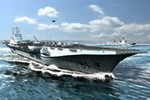Don't fuss over China's first aircraft carrier
Updated: 2011-08-09 15:09
By Huang Shuo (chinadaily.com.cn)
|
|||||||||||
The construction of China's first aircraft carrier is no longer a secret. Not that it ever has been. Hong Kong Commercial Daily first quoted Chen Bingde, chief of the General Staff of the People's Liberation Army, back in June saying "China is building its first-ever air carrier based on the refurbished 990-foot former Soviet Union carrier Varyag."
China possessing an aircraft carrier should be considered a drastic, but necessary move in line with the growth of China's economic power. Firstly, China is increasingly dependent on overseas markets, and needs the carrier for maritime security to protect the annual 200 million tons of oil transported here. In the second place, China, as a great power, has the necessity and legitimacy to develop its own military forces. The construction of the aircraft carrier also means the national defense of China's marine area will become more conscious. Third, China has a blue territory amounting to three million square kilometers and a long coastline. For defending the security of its oceanic territory, the nation should build its own aircraft carriers. In the fourth place, from the perspective of technology, the carriers' demands for advanced and new technologies and weapons is bound to stimulate innovations in related fields of scientific research and boost the overall national defensive strength.
The website "South Korean Navy" analyzed China's first aircraft carrier, Varyag, which was bought for $20 million from Ukraine in 1998, in comparison to India's aircraft carrier and concluded that Varyag had an overall better performance. Korea Daily said that if the aircraft carrier enters the Yellow Sea, all the South Korean airspace would be within range of its fighters. It reported that it was still a "worry" even if the carrier is used as a test platform. Meanwhile, observers from Japan judged that although there are many disputes in China, such as whether the aircraft carrier in China, neighboring countries, especially the South China Sea brought controversy and hostility, recent official statement seem to confirm that they believed the aircraft carrier will be used to win this dispute.
It seemed the aircraft turned some of China's neighbors unnecessarily nervous. After all China does not want to bully neighboring countries with it. The aircraft carrier is itself a defensive posture and part of China's efforts to protect its long coastlines. In addition, the carrier can be used to protect China's interests overseas, including fighting against piracy and protection of Chinese cargo vessels.
For China's water safety and navigation safety we need to have a defensive aircraft carrier, in addition, carriers can also be used for peaceful uses and non-traditional security issues such as humanitarian disaster relief, counter-terrorism, and anti-piracy.
China's first air carrier is never meant to solve disputes with China's neighbors. It is at most part of China's normal military modernization.
On the other hand, China is unlikely to resort to the air carrier to solve disputes with any country for a long period of time. First, it takes generally a whole decade for a newly built aircraft carrier to join an actual battle. Every aircraft carrier needs a crew of several thousand in size, as well as countless subsidiary weapon systems; that mean a long time of training and production work. Even after taking in its first aircraft carrier, China's navy would wait for another ten years to see any evident increase in battle effectiveness.
Second, although many western military magazines list China's naval force among the top three in the world, its actual force is not so strong. It is the giant size (an estimated tonnage of 2 million tons and more than 200 thousand personnel members) that contributed to China's high rank in naval power, but in fact China's navy is mainly composed of defensive forces like small-sized battleships and submarines, which decides its role as defender rather than offender. Besides, lack of the most basic overseas support system has also set a tight limit upon the operation range of China's navy.
Even with an aircraft, China's navy can only keep its defensive role. Therefore China's military development will not change China's defense strategy with self-defense at the core. Therefore neighboring countries should not feel worried. There is no need to fear, just as General Chen Bingde pointed out during his visit to the US this May.
"We are currently re-fitting the body of an old aircraft carrier, and will use it for scientific research, experiments and training," Geng Yansheng, spokesman with China's Defense Ministry, stated at the press conference on July 27. The official statement made clear the aim of China's carrier.
The author can be reached at larryhuangshuo@yahoo.com. The views expressed here do not necessarily reflect those of the China Daily Website.




